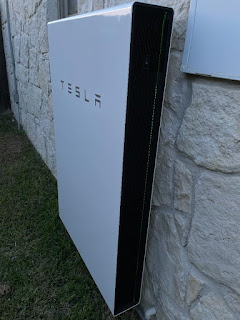WACO TRIBUNE-HERALD COLUMN: How Virtual Power Plants (VPP) Work
In an August 23, 2023 press release, the Public Utilities Commission of Texas (PUCT), announced that two “virtual power plants (VPPs)” were certified to provide electricity to Texas. Review of the necessity of this initiative, and details of implementation are warranted.
Power
Outage Risk. The impetus for this program appears to be
the fragility of the Texas grid. The danger of electric power outages in Texas
was dramatically highlighted during Winter Storm Uri in February 2021. According
to www.poweroutage.us, 4.4 million Texans suffered power outages during Uri,
including up to 30% of McLennan County customers. One hundred forty-six Texans died of
hypothermia, with power outages a probable contributor to most of these deaths.
The following year, a winter storm,
December 23 to 25, 2022, produced blackouts impacting more than 87,000 Texans,
with about 36 deaths nationally. And
during the current brutally hot Texas summer, more than 100,000 Texans
reportedly lost power—a glaring risk for heat illness and death. Rolling
blackouts were narrowly avoided, including in Bexar County in June.
Aggregate
Distributed Energy Resource (ADER). To address Texas’
shaky power grid and avoid blackouts, the Public Utility Commission has
directed development of pilot programs of Aggregate Distributed Energy Resources. The term ADER basically refers to using large
numbers of very small, scattered, consumer power sites, which add up to a significant
amount of electricity. (These small “distributed” power sources contrast
with “utility scale” power, such as the familiar wind farms, solar farms, and
natural gas power plants). The ADERs will be created and operated by the
numerous retail electricity providers, such as TXU Energy, HOT Electric Co-op,
and Direct Energy. The individual
sites/devices in each ADER must be less than 1MW each and the cumulative power
must be at least 100kW. (As a point of
reference, my Tesla home Powerwall battery is 13.5 kWh.) The Public Utility Commission announced that
the first two ADERs in Texas would derive from people with Tesla home
batteries, residing in the Houston or Dallas areas.
The primary sources for consumers to
contribute power to the grid are from home batteries, EV batteries, and demand
response appliances.
Battery
Storage. Since
residences and businesses with photovoltaic systems cannot power their facility
when the grid is down (a blackout), the addition of a home battery does allow
the system to power its
building during an outage. In many cases, the battery is used only
during blackout situations, thus considerable power is stored which could be
used during times of grid insufficiency.
The result is termed a virtual powerplant (VPP), because new power is
contributed to the grid, without a new, visible “plant.” Consumers are reimbursed for the power they
provide, as they improve grid reliability.
Some common home batteries include the Tesla Powerwall (13.5kWh),
Generac PWRcell (9.0kWh), and Panasonic Evervolt (11.4kWh).
Electric
Vehicle (EV) Chargers.
Unlike common unidirectional chargers
that charge from the grid to the EV, bidirectional chargers also allow power to
flow from the EV battery to the grid. Since
EV batteries may be very large, 100kWh or more, they can provide an enormous
source of power that can assist the grid.
The German EcoG and Wallbox Quasar are bidirectional chargers currently
available. Reportedly, the F-150
Lightning, Nissan Leaf, Hyundai Ioniq5, and Kia EV6 are compatible with
bidirectional charging. However, this
technology requires synchrony between EV, charger, and grid, and is not yet
operational in Texas to my knowledge.
The PUC press release suggests pilot programs are developing this source
of power for the grid as well.
Demand
Response Appliances. These communicative water heaters, smart
thermostats, and HVAC systems allow utilities to lower the device’s electricity
use during times of peak demand, thus helping to stabilize the grid. Home comfort will be minimally impacted, but
the decreased consumption by thousands of devices may significantly improve
grid resilience. Rheem, for example, manufactures electric water heaters that
are demand response -ready. Further, by acting on the consumption side of
electricity balance, GHG emissions are lowered—because the cleanest power is
the power that is not used.
Backup Generators.
Although this modality is mentioned in the press release, these devices
burn fossil fuels, produce GHGs, and are not an acceptable power source, in my
view.
Status.
The Public Utility Commission of Texas announced that there are
currently eight pilot ADER projects, totaling 7.2mW, and that two of these are
in full operation, both Tesla Powerwall virtual power plants, in the Houston
and Dallas areas. Since the State of
Texas has its own isolated grid, the formation of these VPPs may have increased
the reliability of the grid for Wacoans.
As the pilot programs spread to smaller cities, Waco citizens may have
the opportunity to participate, if they have rooftop solar with a Tesla home
battery. Purchasing an EV with
bidirectional charging capability may also provide eligibility to participate
in selling EV battery power to the grid in the future.
By
installing rooftop solar with battery storage, and transitioning to an EV, one powerfully
combats the climate crisis. In addition,
with this announcement by the Public Utility Commission, one may also
contribute to improving the reliability and resilience of the Texas power
grid.
Alan D.
Northcutt, M.D.
August 29,
2023
Alan D. Northcutt is a retired Waco
physician and Director of the grassroots climate action and education group,
Waco Friends of the Climate. For free “Climate Crisis is Here” yard signs,
email anorthc@aol.com.
ost Teamplate

Comments
Post a Comment